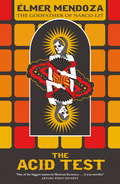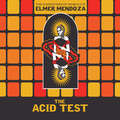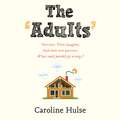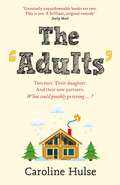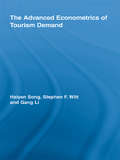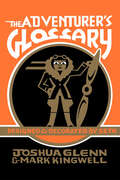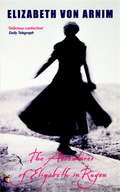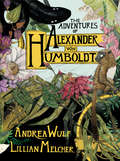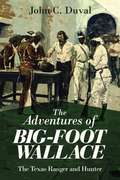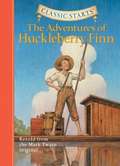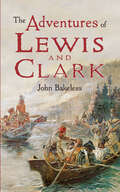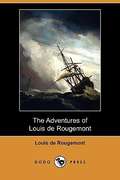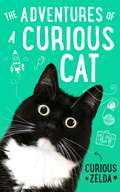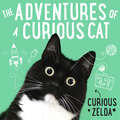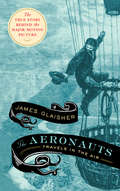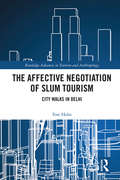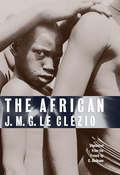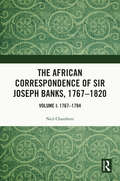- Table View
- List View
The Acid Test
by Élmer MendozaEgdar "Lefty" Mendieta investigates the death of a notorious stripper in this second sweltering "Narco-lit" noir from the Godfather of Mexican crime fictionAn intelligent, atmospheric police procedural series for fans of John Le Carré and Mick HeronWhen the mutilated body of Mayra Cabral de Melo is found in a dusty field, Detective Edgar "Lefty" Mendieta has personal reasons for bringing the culprit to justice. Mayra, a well-known stripper, had no shortage of ardent, deluded and downright dangerous admirers, and Lefty himself is haunted by the night he spent in her company.As Mexico's drug war ramps up, Lefty's pursuit of a gallery of jealous and powerful suspects, all with a murderous glint in their eye, leads him to Samantha Valdés, the godfather's daughter, who is battling to retain her father's empire. And as the mystery deepens, the bodycount rises.
The Acid Test
by Élmer MendozaEgdar "Lefty" Mendieta investigates the death of a notorious stripper in this second sweltering "Narco-lit" noir from the Godfather of Mexican crime fictionAn intelligent, atmospheric police procedural series for fans of John Le Carré and Mick HeronWhen the mutilated body of Mayra Cabral de Melo is found in a dusty field, Detective Edgar "Lefty" Mendieta has personal reasons for bringing the culprit to justice. Mayra, a well-known stripper, had no shortage of ardent, deluded and downright dangerous admirers, and Lefty himself is haunted by the night he spent in her company.As Mexico's drug war ramps up, Lefty's pursuit of a gallery of jealous and powerful suspects, all with a murderous glint in their eye, leads him to Samantha Valdés, the godfather's daughter, who is battling to retain her father's empire. And as the mystery deepens, the bodycount rises.
The Acid Test
by Élmer MendozaWhen the mutilated body of Mayra Cabral de Melo, a well-known stripper, is found by the side of a dusty road, detective Edgar "Lefty" Mendieta has personal reasons for bringing the culprit to justice. Mayra had no shortage of ardent, deluded and downright dangerous admirers, and Lefty himself is haunted by one steamy night he spent in her generous company. So begins an investigation that will bring him ever closer to the murderous world of the narcos, who are waging a war of bloody attrition against the Mexican state. The country is a powder keg, waiting for a spark, and Mendieta is about to enter the darkest days of his life. Corrupt politicians, failed boxers and unscrupulous arms dealers all lie in wait across the path to justice - none of which can prepare him for a brush with the F.B.I. when the father of the President of the United States is attacked on vacation. But for all these perils it is the weight of his own murky past that Lefty finds hardest to bear.And as he scratches around for clues, faced with a gallery of suspects who all have a motive and that murderous glint in their eye, the reappearance of Samantha Valdés, now the boss of the Cartel del Pacífico, adds one more piece to an already impenetrable puzzle.(P)2016 WF Howes Ltd
The Adrenaline Junkie's Bucket List: 100 Extreme Outdoor Adventures to Do Before You Die
by Christopher Van TilburgThe Adrenaline Junkie's Bucket List provides a heart-stopping and essential guide to the best extreme outdoor adventures on every continent.Imagine kayaking the churning whitewater of Africa's wild and wet Zambezi River. Getting barreled in a wave surfing Fiji's legendary Cloudbreak reef. Trekking New Zealand's famed Milford Track through the lush, green fiords.This book is the ultimate guide for the outdoor and sports enthusiasts seeking out the world's most fantastic adventures. It runs the gamut of water, mountain and hiking sports for all skill levels—from beginners to experts. Written by a veteran outdoor adventure expert, author and wilderness physician Christopher Van Tilburg, it presents readers with one hundred amazing and challenging voyages all over the world. Organized by continent, the book offers fifteen to twenty-five trips of a wide variety in each section, and also covers local lore and history, hotel and restaurant recommendations, and other relevant services. Sidebars throughout contain practical advice for the adventure travel enthusiast on health, safety, and outdoor life.This is the perfect book for extreme athletes and armchair travelers looking for an adventurous read.
The Adults: A Christmas vacation with your ex. What could go wrong?
by Caroline Hulse'Genuinely unputdownable books are rare in my experience. This is one. A brilliant, original comedy' Daily Mail* * * * *MEET THE ADULTS...Claire and Matt are divorced but decide what's best for their daughter Scarlett is to have a 'normal' family Christmas with them all together.Claire brings her new boyfriend Patrick, a seemingly eligible Iron-Man-in-Waiting. Matt brings the new love of his life Alex, funny, smart, and extremely patient. Scarlett, their daughter, brings her imaginary friend Posey. He's a rabbit.Together the five (or six?) of them grit their teeth over Organized Fun activities, drinking a little too much after bed-time, oversharing classified secrets about their pasts and, before they know it, their holiday is a powder keg that ends - where this story starts - with a tearful, frightened, call to the police...But what happened? They said they'd all be adults about this...* * * * *'I loved The Adults! Funny, dry and beautifully observed. Highly recommended' Gill Sims, #1 bestselling author of Why Mummy Drinks and Why Mummy Swears'Such a breath of fresh air! Witty, intensely human and (dare I say it) relatable ... The perfect comedy of errors' Katie Khan'The Adults is my top read of 2018 so far. Absolutely hilarious ... This one will stay with me for a long time' Cathy Bramley 'Packed with sharp wit, engaging characters and off-beat humour, this is a fresh and feisty thrill-ride of a novel' Heat'I took this book on holiday and couldn't put it down! I've never read anything quite like it' The Unmumsy Mum'Gripped me from the start. Reminiscent of Liane Moriarty's Big Little Lies - a sure-fire winner' Cass Hunter, author of The After Wife'Brilliantly funny - will have you wincing in recognition' Good Housekeeping'Funny, poignant, real - a truly original book that made me laugh, cry and cringe in equal measure. I loved it' Charlotte Duckworth'Razor-sharp comedy - barbed and brilliant. The characters are totally convincing ... Sparky, heart-felt and fantastically fun, this is a fabulous debut' Sunday Mirror
The Adults: Two exes. Their daughter. And their new partners. What could possibly go wrong?
by Caroline Hulse'Genuinely unputdownable books are rare in my experience. This is one. A brilliant, original comedy' Daily Mail* * * * *MEET THE ADULTS...Claire and Matt are divorced but decide what's best for their daughter Scarlett is to have a 'normal' family Christmas with them all together.Claire brings her new boyfriend Patrick, a seemingly eligible Iron-Man-in-Waiting. Matt brings the new love of his life Alex, funny, smart, and extremely patient. Scarlett, their daughter, brings her imaginary friend Posey. He's a rabbit.Together the five (or six?) of them grit their teeth over Organized Fun activities, drinking a little too much after bed-time, oversharing classified secrets about their pasts and, before they know it, their holiday is a powder keg that ends - where this story starts - with a tearful, frightened, call to the police...But what happened? They said they'd all be adults about this...* * * * *'I loved The Adults! Funny, dry and beautifully observed. Highly recommended' Gill Sims, #1 bestselling author of Why Mummy Drinks and Why Mummy Swears'Such a breath of fresh air! Witty, intensely human and (dare I say it) relatable ... The perfect comedy of errors' Katie Khan'The Adults is my top read of 2018 so far. Absolutely hilarious ... This one will stay with me for a long time' Cathy Bramley 'Packed with sharp wit, engaging characters and off-beat humour, this is a fresh and feisty thrill-ride of a novel' Heat'I took this book on holiday and couldn't put it down! I've never read anything quite like it' The Unmumsy Mum'Gripped me from the start. Reminiscent of Liane Moriarty's Big Little Lies - a sure-fire winner' Cass Hunter, author of The After Wife'Brilliantly funny - will have you wincing in recognition' Good Housekeeping'I have a feeling Caroline Hulse might be a genius, this book is so brilliant. t's funny, clever and original - I loved every minute of reading it. Also, Posey should get a spin-off TV show' Lucy Vine, author of Hot Mess'Funny, poignant, real - a truly original book that made me laugh, cry and cringe in equal measure. I loved it' Charlotte Duckworth'Razor-sharp comedy - barbed and brilliant. The characters are totally convincing ... Sparky, heart-felt and fantastically fun, this is a fabulous debut' Sunday Mirror
The Advanced Econometrics of Tourism Demand (Routledge Advances In Tourism Ser.)
by Gang Li Haiyan Song Stephen F. WittTourism demand is the foundation on which all tourism-related business decisions ultimately rest. Governments and companies such as airlines, tour operators, hotels, cruise ship lines, and recreation facility providers are interested in the demand for their products by tourists. The success of many businesses depends largely or totally on the state
The Adventurer's Glossary
by Joshua Glenn Mark KingwellAdventure is always escapist and often utopian, yet we find solidarity with others and Kafkaesque existential rabbit holes within the words we use to celebrate high-flying escapades. Even when adventures are small in the cosmic scope, the terminology of thrilling exploits promotes a life lived at a high pitch. This go-to glossary for the philosophical explorer delves into these contradictions and insights through more than five hundred terms, from A-OK to zoom. Semiotician Joshua Glenn sourced terms from Shakespeare, military and biker jargon, hip hop and surfer slang, survivalist and gamer subcultures, comic books, extreme sports, and beyond to ask questions about meaning and selfhood. This diverting survey, paired with copious illustrations by the acclaimed cartoonist Seth, is introduced by Mark Kingwell in a thought-provoking essay.The Adventurer’s Glossary extends the entertaining and incisive critique found in the trio’s previous books, The Idler’s Glossary and The Wage Slave’s Glossary. This third instalment turns its lens to the language of risk, excitement, and journeying into the unknown, taking readers on their own semantic adventure.
The Adventures Of Elizabeth In Rugen: A Virago Modern Classic (Virago Modern Classics #397)
by Elizabeth von ArnimIn 1901 the 'real' Elizabeth holidayed on the Baltic island of Rügen with just her maid, a coachman, a carriage piled with luggage, and a woman friend. From such unpromising beginnings Elizabeth weaves a captivating farrago around her encounters. There's the snobbish bishop's wife and her personable, handsome son, a dressmaker and, astonishingly, a long-lost cousin -- Charlotte -- who is trying to evade the pursuit of her husband, the maddeningly genial old professor. Here, with delightfully astringent humour, Elizabeth recounts the misadventures that befall her. And, as she immortalised her Pomeranian wilderness in the famous ELIZABETH AND HER GERMAN GARDEN, she now writes enticingly of this remote and attractive island.
The Adventures of Alexander Von Humboldt (Pantheon Graphic Library)
by Andrea WulfA KIRKUS REVIEWS BEST BOOK OF THE YEARFrom the New York Times bestselling author of The Invention of Nature, comes a breathtakingly illustrated and brilliantly evocative recounting of Alexander Von Humboldt's five year expedition in South America. Alexander von Humboldt (1769-1859) was an intrepid explorer and the most famous scientist of his age. His restless life was packed with adventure and discovery, but his most revolutionary idea was a radical vision of nature as a complex and interconnected global force that does not exist for the use of humankind alone. His theories and ideas were profoundly influenced by a five-year exploration of South America. Now Andrea Wulf partners with artist Lillian Melcher to bring this daring expedition to life, complete with excerpts from Humboldt's own diaries, atlases, and publications. She gives us an intimate portrait of the man who predicted human-induced climate change, fashioned poetic narrative out of scientific observation, and influenced iconic figures such as Simón Bolívar, Thomas Jefferson, Charles Darwin, and John Muir. This gorgeous account of the expedition not only shows how Humboldt honed his groundbreaking understanding of the natural world but also illuminates the man and his passions.
The Adventures of Big-Foot Wallace: The Texas Ranger and Hunter
by John C. DuvalThe thrilling adventures of traveler, rancher, and fighter "Big-Foot” Wallace in a bygone era of the American frontier.Amid the embroiling conflicts of frontiersmen, Mexicans, and war in Texas, 1837, William "Big-Foot” Wallace left his hometown of Virginia to avenge the deaths of his brother and cousin, soldiers executed by Mexicans. Upon joining the Texas Rangers, Wallace was swept into the clashes at Salado Creek, Hondo River, and the Battle of Monterrey during the Mexican-American War. Measuring at 6 feet 2 inches tall and weighing 240 pounds, Big-Foot Wallace embodied the iron nerves and indomitable spirit of the Texan frontiersman. In one of his most famous and harrowing experiences during the Mier expedition, Wallace was captured by the Mexican army, blindfolded, and forced to draw from a pot of black and white beans to determine whether he would be imprisoned or executed. Wallace drew a white bean and lived. After the war, he returned from the wilderness to clean, civilized Virginia, and spent the rest of his days as a storytelling, yarn-spinning rancher. John Duval, fellow Texas Ranger and Wallace’s best friend, gives a thrilling but factual account of the man’s life in a simple but engaging narrative style, combining action, suspense, and dry Texan humor. Wallace’s hairbreadth escapes and larger-than-life story are the perfect representation of the Old West in all its perils, comedy, and romance. Skyhorse Publishing, along with our Arcade, Good Books, Sports Publishing, and Yucca imprints, is proud to publish a broad range of biographies, autobiographies, and memoirs. Our list includes biographies on well-known historical figures like Benjamin Franklin, Nelson Mandela, and Alexander Graham Bell, as well as villains from history, such as Heinrich Himmler, John Wayne Gacy, and O. J. Simpson. We have also published survivor stories of World War II, memoirs about overcoming adversity, first-hand tales of adventure, and much more. While not every title we publish becomes a New York Times bestseller or a national bestseller, we are committed to books on subjects that are sometimes overlooked and to authors whose work might not otherwise find a home.
The Adventures of Captain Bonneville
by Washington IrvingThe expeditions and adventures of Captain Bonneville, of the United States army, are the theme of this book.
The Adventures of Huckleberry Finn (Abridged)
by Mark Twain Oliver HoTwain's beloved tale, with its folksy language, creates an indelible image of antebellum America with its sleepy river towns, con men, family feuds, and a variety of colorful characters.
The Adventures of Lewis and Clark (Dover Children's Classics)
by John BakelessIn 1803, when the United States purchased the Louisiana Territory from France (for a scant $15 million), it doubled the size of the young country. Stretching north from New Orleans to the Canadian border and westward from the Mississippi River to the Rocky Mountains, the area contained over 800,000 square miles. That same year, President Thomas Jefferson designated two young men — Meriweather Lewis and William Clark — as leaders of an expedition to explore this vast new acquisition, as well as other lands of the West. In the spring of 1804, the two men and an intrepid band of hunters, carpenters, gunsmiths, and blacksmiths, known as the "Corps of Discovery," embarked on a perilous journey that would truly give meaning to the term "Wild West." In this exciting, action-packed young reader's edition, based on the author's acclaimed earlier study of the two great American explorers, historian John Bakeless chronicles the daily challenges these men faced — from encounters with indigenous people, snake-infested waterways, prairie fires, floods, heat, and thirst, to illness, famine, and frigid mountain passes. The result is a saga of epic proportions, an amazing story of courage and determination sure to delight readers with its authenticity and vivid, dramatic style.
The Adventures of Louis de Rougemont
by Louis De RougemontLouis de Rougemont (1847-1921) was a would-be explorer who claimed to have had adventures in Australasia. "de Rougemont" was born Henri Louis Grin in 1847 in Suchy, Switzerland. <P> <P> In 1898 he began to write about his invented adventures in the British periodical The Wide World Magazine under the name Louis de Rougemont. He described his alleged exploits in search of pearls and gold in New Guinea and claimed to have spent thirty years living with Indigenous Australians in the Australian outback. He claimed that the tribe with whom he had lived had worshipped him as a god. He also claimed to have encountered the Gibson expedition of 1874. Various readers expressed disbelief in his tales from the start, for example, claiming that no one can actually ride a turtle. He had also claimed to have seen flying wombats. The fact that he could not place his travels on the map aroused suspicion. Readers' arguments in the pages of London newspaper, the Daily Chronicle, continued for months.
The Adventures of Robinson Crusoe
by Daniel Defoe"Robinson Crusoe" is about an adventurer who is shipwrecked on a desert island, The book contains adventure of all sorts: pirates, shipwrecks, cannibals, mutiny, and so much more... The book was written by Daniel Defoe and was first published in 1719.
The Adventures of Robinson Crusoe (Great Illustrated Classics)
by Daniel Defoe Malvina G. VogelA great illustrated classics: The Adventures of Robinson Crusoe
The Adventures of a Curious Cat: wit and wisdom from Curious Zelda, purrfect for cats and their humans
by Curious Zelda'A purrfect gift for a loved one with a special affinity for the feline' 'An absolute must for any cat lover''Curiosity is more than a desire to discover. It's a lifestyle, and a purrvilege. It's hours of observing a fly on the wall. It's entering the sock drawer just before it closes. It's sniffing the lampshade one more time . . .'Such is the wisdom of Curious Zelda: social media star, agony aunt, yoga teacher, cat. In The Adventures of a Curious Cat she gives insight into her view of the world and dispenses unparalleled wisdom. Zelda explains, in her unique voice, how to handle humans, how to communicate with furniture, and most importantly how to live a life curiously. It's the ultimate self-help guide for any cat, or indeed, their human.
The Adventures of a Curious Cat: wit and wisdom from Curious Zelda, purrfect for cats and their humans
by Curious Zelda'A purrfect gift for a loved one with a special affinity for the feline''An absolute must for any cat lover''Curiosity is more than a desire to discover. It's a lifestyle, and a purrvilege. It's hours of observing a fly on the wall. It's entering the sock drawer just before it closes. It's sniffing the lampshade one more time . . .'Such is the wisdom of Curious Zelda: social media star, agony aunt, yoga teacher, cat. In The Adventures of a Curious Catshe gives insight into her view of the world and dispenses unparalleled wisdom. Zelda explains, in her unique voice, how to handle humans, how to communicate with furniture, and most importantly how to live a life curiously. It's the ultimate self-help guide for any cat, or indeed, their human.
The Adventures of a Curious Cat: wit and wisdom from Curious Zelda, purrfect for cats and their humans
by Curious Zelda'Curiosity is more than a desire to discover. It's a lifestyle, and a purrvilege. It's hours of observing a fly on the wall. It's entering the sock drawer just before it closes. It's sniffing the lampshade one more time . . .'Such is the wisdom of Curious Zelda: social media star, agony aunt, yoga teacher, cat. In The Adventures of a Curious Cat she gives insight into her view of the world and dispenses unparalleled wisdom. Zelda explains, in her unique voice, how to handle humans, how to communicate with furniture, and most importantly how to live a life curiously. It's the ultimate self-help guide for any cat, or indeed, their human.
The Aeronauts: Travels in the Air
by James GlaisherThe True Story Behind the Major Motion Picture — and one of the greatest daredevil stories in the history of aviationIn 1862, ambitious scientist James Glaisher set out to do the impossible: ascend higher into the skies than ever before. A pioneer of weather forecasting and of photography, and a founding member of the Royal Meteorological Society, he wanted to take ground-breaking research measurements from different altitudes. On 5th September, along with experienced balloonist Henry Coxwell as his pilot, he lifted off in a hot air balloon for what would prove to be a death-defying and historic flight. Rising above the English countryside, they rose to the remarkable height of 37,000 feet (7 miles or 11km), almost killing both men, who experienced blurred vision, loss of motor function and, eventually, unconsciousness. It was a miracle they survived to tell the tale. Written in his own words, The Aeronauts chronicles Glaisher’s incredible flights and discoveries first hand, as well as his observations on those pioneers who came before and inspired him. His audaciously daring journey forms the story of the forthcoming major motion picture The Aeronauts. With an introduction by Professor Liz Bentley, Chief Executive at the Royal Meteorological Society
The Affective Negotiation of Slum Tourism: City Walks in Delhi (Routledge Advances in Tourism and Anthropology)
by Tore HolstEach year, approximately a million tourists visit slum areas on guided tours as a part of their holiday to Asia, Africa or Latin America. This book analyses the cultural encounters that take place between slum tourists and former street children, who work as tour guides for a local NGO in Delhi, India. Slum tours are typically framed as both tourist performances, bought as commodities for a price on the market, and as appeals for aid that tourists encounter within an altruistic discourse of charity. This book enriches the tourism debate by interpreting tourist performances as affective economies, identifying tour guides as emotional labourers and raising questions on the long-term impacts of economically unbalanced encounters with representatives of the Global North, including the researcher. This book studies the ‘feeling rules’ governing a slum tour and how they shape interactions. When do guides permit tourists to exoticise the slum and feel a thrilling sense of disgust towards the effects of abject poverty, and when do they instead guide them towards a sense of solidarity with the slum’s inhabitants? What happens if the tourists rebel and transgress the boundaries delimiting the space of comfortable affective negotiation constituted by the guides? This book will be essential reading for undergraduates, postgraduates and researchers working within the fields of Human Geography, Slum Tourism Research, Subaltern Studies and Development Studies.
The African
by J. M. G. Le ClézioThe African is a short autobiographical account of a pivotal moment in Nobel-Prize-winning author J. M. G. Le Clézio's childhood. In 1948, young Le Clézio, with his mother and brother, left behind a still-devastated Europe to join his father, a military doctor in Nigeria, from whom he'd been separated by the war. In Le Clézio's characteristically intimate, poetic voice, the narrative relates both the dazzled enthusiasm the child feels at discovering newfound freedom in the African savannah and his torment at discovering the rigid authoritarian nature of his father. The power and beauty of the book reside in the fact that both discoveries occur simultaneously.
The African Correspondence of Sir Joseph Banks, 1767–1820: Volume I: 1767–1794
by Neil ChambersThis edition brings together in three fully edited volumes the correspondence and associated papers of Sir Joseph Banks regarding European and especially British exploration of Africa from 1767–1820, for the first time publishing this globally scattered material in one place, thereby revolutionizing its availability and understanding of the activities of a key figure who helped organize and publish a series of missions to penetrate the African interior, mainly from West Africa and by crossing the Sahara from Cairo and Tripoli. Banks was a founder in 1788 of the African Association, which mounted many of these missions, including those of Mungo Park to explore the River Niger, and J.L. Burkhardt exploring Syria, Arabia and Egypt. At the time, little was known about the African interior, its peoples, kingdoms and resources, and the aim of the African Association under Banks was to discover what lay there, to make contact with and study its societies, to map them and their lands and help establish trading links. Banks also maintained a lively correspondence with British diplomatic representatives in North Africa, such as James Mario Matra at Tangier and Henry Salt in Cairo, who were a rich source of news. Moreover, as unofficial director of the royal gardens at Kew he sent pioneering plant collectors to gather plants in South Africa, vastly boosting knowledge of this region’s important flora. At home, he corresponded with politicians, government officials, entrepreneurs, navigators, naturalists and campaigners like William Wilberforce about a great range of issues surrounding Africa. This work is multi-disciplinary and will stand alongside existing series of Banks’s correspondence published by Neil Chambers (Scientific Correspondence, 2007; Indian and Pacific Correspondence, 2007–14). It will appeal to scholars of African history in the Early Modern Period, to those studying exploration and collecting as well as those interested in natural history, the history of science, geography, cartography and the Enlightenment. An Introduction, detailed Calendar of Correspondents, Timelines for each volume and a comprehensive Index supplement the footnotes to nearly 800 documents included in this fascinating and comprehensive new series.
The African Correspondence of Sir Joseph Banks, 1767–1820: Volume II: 1795–1803
by Neil ChambersThis edition brings together in three fully edited volumes the correspondence and associated papers of Sir Joseph Banks regarding European and especially British exploration of Africa from 1767–1820, for the first time publishing this globally scattered material in one place, thereby revolutionizing its availability and understanding of the activities of a key figure who helped organize and publish a series of missions to penetrate the African interior, mainly from West Africa and by crossing the Sahara from Cairo and Tripoli. Banks was a founder in 1788 of the African Association, which mounted many of these missions, including those of Mungo Park to explore the River Niger, and J.L. Burkhardt exploring Syria, Arabia and Egypt. At the time, little was known about the African interior, its peoples, kingdoms and resources, and the aim of the African Association under Banks was to discover what lay there, to make contact with and study its societies, to map them and their lands and help establish trading links. Banks also maintained a lively correspondence with British diplomatic representatives in North Africa, such as James Mario Matra at Tangier and Henry Salt in Cairo, who were a rich source of news. Moreover, as unofficial director of the royal gardens at Kew he sent pioneering plant collectors to gather plants in South Africa, vastly boosting knowledge of this region’s important flora. At home, he corresponded with politicians, government officials, entrepreneurs, navigators, naturalists and campaigners like William Wilberforce about a great range of issues surrounding Africa. This work is multi-disciplinary and will stand alongside existing series of Banks’s correspondence published by Neil Chambers (Scientific Correspondence, 2007; Indian and Pacific Correspondence, 2007–14). It will appeal to scholars of African history in the Early Modern Period, to those studying exploration and collecting as well as those interested in natural history, the history of science, geography, cartography and the Enlightenment. An Introduction, detailed Calendar of Correspondents, Timelines for each volume and a comprehensive Index supplement the footnotes to nearly 800 documents included in this fascinating and comprehensive new series.
